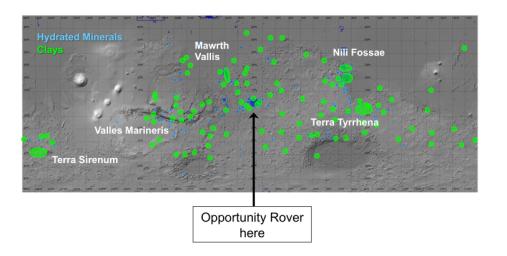
|
Regions of Mars with Clays and Hydrated Minerals Identified from Orbit
- Click the image above for a larger view
- Full-Res JPEG (2999 x 1515) (581.5 kB)
- Full-Res TIFF (2999 x 1515) (13.6 MB)
Caption:
On this map of Mars, areas indicated in green are where spectrometers on spacecraft orbiting Mars have detected clay minerals and areas indicated in blue are where those spectrometers have detected hydrated minerals (clays, sulfates and others).
Both clay and sulfate minerals are important for understanding past environmental conditions on Mars.
Detections mapped here were made by the OMEGA visible and infrared mineralogical mapping spectrometer (Observatoire pour la Minéralogie, l'Eau, les Glaces et l'Activité) on the European Space Agency's Mars Express orbiter and by the Compact Reconnaissance Imaging Spectrometer for Mars (CRISM) on NASA's Mars Reconnaissance Orbiter, reported by Bethany Ehlmann and François Poulet of the Institut d'Astrophysique Spatiale, Orsay, France, and Janice Bishop of the SETI Institute and NASA Ames Research Center, Mountain View, Calif.
Observations by these spectrometers identified the hydrated minerals, including clays, after NASA's Mars Exploration Rover Opportunity had landed in January 2004, but the rover is still active, and is now close to exposures seen from orbit of each of these types of minerals.
The base map is shaded topography based on data from the Mars Orbiter Laser Altimeter on NASA's Mars Global Surveyor orbiter.
Cataloging Keywords:
| Name | Value | Additional Values |
|---|---|---|
| Target | Mars | |
| System | ||
| Target Type | Planet | |
| Mission | Mars Express (MEX) | Mars Exploration Rover (MER), Mars Express, Mars Global Surveyor (MGS), Mars Reconnaissance Orbiter (MRO) |
| Instrument Host | Mars Reconnaissance Orbiter | Mars Express, Mars Express Orbiter, Mars Global Surveyor, Opportunity (MER-B) |
| Host Type | Orbiter | Rover |
| Instrument | Altimeter | Compact Reconnaissance Imaging Spectrometer for Mars (CRISM), Visible and Infrared Mineralogical Mapping Spectrometer (OMEGA) |
| Detector | ||
| Extra Keywords | Color, Infrared, Map, Mountain | |
| Acquisition Date | ||
| Release Date | 2010-12-16 | |
| Date in Caption | ||
| Image Credit | NASA/JPL-Caltech/Cornell University | |
| Source | photojournal.jpl.nasa.gov/catalog/PIA13703 | |
| Identifier | PIA13703 | |
